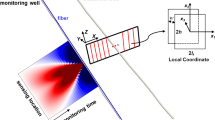Abstract
Many aspects of earthquake source dynamics like dynamic stress drop, rupture velocity and directivity, etc. are currently inferred from the source time functions obtained by a deconvolution of the propagation and recording effects from seismograms. The question of the accuracy of obtained results remains open. In this paper we address this issue by considering two aspects of the source time function deconvolution. First, we propose a new pseudo-spectral parameterization of the sought function which explicitly takes into account the physical constraints imposed on the sought functions. Such parameterization automatically excludes non-physical solutions and so improves the stability and uniqueness of the deconvolution. Secondly, we demonstrate that the Bayesian approach to the inverse problem at hand, combined with an efficient Markov Chain Monte Carlo sampling technique, is a method which allows efficient estimation of the source time function uncertainties. The key point of the approach is the description of the solution of the inverse problem by the a posteriori probability density function constructed according to the Bayesian (probabilistic) theory. Next, the Markov Chain Monte Carlo sampling technique is used to sample this function so the statistical estimator of a posteriori errors can be easily obtained with minimal additional computational effort with respect to modern inversion (optimization) algorithms. The methodological considerations are illustrated by a case study of the mining-induced seismic event of the magnitude M L ≈3.1 that occurred at Rudna (Poland) copper mine. The seismic P-wave records were inverted for the source time functions, using the proposed algorithm and the empirical Green function technique to approximate Green functions. The obtained solutions seem to suggest some complexity of the rupture process with double pulses of energy release. However, the error analysis shows that the hypothesis of source complexity is not justified at the 95% confidence level. On the basis of the analyzed event we also show that the separation of the source inversion into two steps introduces limitations on the completeness of the a posteriori error analysis.
Similar content being viewed by others
Author information
Authors and Affiliations
Corresponding author
Rights and permissions
About this article
Cite this article
Dȩbski, W. Estimating the Earthquake Source Time Function by Markov Chain Monte Carlo Sampling. Pure appl. geophys. 165, 1263–1287 (2008). https://doi.org/10.1007/s00024-008-0357-1
Received:
Accepted:
Published:
Issue Date:
DOI: https://doi.org/10.1007/s00024-008-0357-1




